Non-Iridescent Metal Nanomesh with Disordered Nanoapertures Fabricated by Phase Separation Lithography of Polymer Blend as Transparent Conductive Film
Abstract
1. Introduction
2. Materials and Methods
2.1. Materials
2.2. Preparation of PPSQ/PS Blend Films
2.3. Preparation of Metallic nanomesh films
2.4. Characterization
3. Results and Discussion
3.1. Strategy for Facile Nanofabrication of Metallic Nanomesh Film with Regulable Amorphous Nanoapertures
3.2. Influences of Thickness, Aperture Size and Duty Cycle of Metal Nanomeshes on Optical Transmittance and Sheet Resistance
3.3. Angle-Independent Non-Iridescent Metallic Nanomesh Films with Disordered Apertures
3.4. Flexibility, Durability and Application Examples
4. Conclusions
Author Contributions
Funding
Institutional Review Board Statement
Informed Consent Statement
Data Availability Statement
Conflicts of Interest
References
- Ellmer, K. Past achievements and future challenges in the development of optically transparent electrodes. Nat. Photon. 2012, 6, 809–817. [Google Scholar] [CrossRef]
- Wang, X.; Zhi, L.; Müllen, K. Transparent, Conductive Graphene Electrodes for Dye-Sensitized Solar Cells. Nano Lett. 2008, 8, 323–327. [Google Scholar] [CrossRef] [PubMed]
- Kim, Y.H.; Sachse, C.; Machala, M.L.; May, C.; Müller-Meskamp, L.; Leo, K. Highly Conductive PEDOT:PSS Electrode with Optimized Solvent and Thermal Post-Treatment for ITO-Free Organic Solar Cells. Adv. Funct. Mater. 2011, 21, 1076–1081. [Google Scholar] [CrossRef]
- Han, B.; Pei, K.; Huang, Y.; Zhang, X.; Rong, Q.; Lin, Q.; Guo, Y.; Sun, T.; Guo, C.; Carnahan, D.; et al. Transparent Conductive Electrodes: Uniform Self-Forming Metallic Network as a High-Performance Transparent Conductive Electrode (Adv. Mater. 6/2014). Adv. Mater. 2014, 26, 980. [Google Scholar] [CrossRef]
- Lee, J.; Lee, P.; Lee, H.; Lee, D.; Lee, S.S.; Ko, S.H. Very long Ag nanowire synthesis and its application in a highly transparent, conductive and flexible metal electrode touch panel. Nanoscale 2012, 4, 6408–6414. [Google Scholar] [CrossRef] [PubMed]
- Wu, H.; Kong, D.; Ruan, Z.; Hsu, P.-C.; Wang, S.; Yu, Z.; Carney, T.J.; Hu, L.; Fan, S.; Cui, Y. A transparent electrode based on a metal nanotrough network. Nat. Nanotechnol. 2013, 8, 421–425. [Google Scholar] [CrossRef]
- Zhang, D.; Ryu, K.; Liu, X.; Polikarpov, E.; Ly, J.; Tompson, A.M.E.; Zhou, C. Transparent, Conductive, and Flexible Carbon Nanotube Films and Their Application in Organic Light-Emitting Diodes. Nano Lett. 2006, 6, 1880–1886. [Google Scholar] [CrossRef]
- Zhou, L.; Xiang, H.-Y.; Shen, S.; Li, Y.-Q.; Chen, J.-D.; Xie, H.-J.; Goldthorpe, I.A.; Chen, L.-S.; Lee, S.-T.; Tang, J.-X. High-Performance Flexible Organic Light-Emitting Diodes Using Embedded Silver Network Transparent Electrodes. ACS Nano 2014, 8, 12796–12805. [Google Scholar] [CrossRef]
- Xu, R.-P.; Li, Y.-Q.; Tang, J.-X. Recent advances in flexible organic light-emitting diodes. J. Mater. Chem. C 2016, 4, 9116–9142. [Google Scholar] [CrossRef]
- Park, S.; Vosguerichian, M.; Bao, Z. A review of fabrication and applications of carbon nanotube film-based flexible electronics. Nanoscale 2013, 5, 1727–1752. [Google Scholar] [CrossRef]
- Lee, M.S.; Lee, K.; Kim, S.Y.; Lee, H.; Park, J.; Choi, K.H.; Kim, H.K.; Kim, D.G.; Lee, D.Y.; Nam, S.; et al. High-Performance, Transparent, and Stretchable Electrodes Using Graphene-Metal Nanowire Hybrid Structures. Nano Lett. 2013, 13, 2814–2821. [Google Scholar] [CrossRef] [PubMed]
- Hecht, D.S.; Hu, L.; Irvin, G. Emerging Transparent Electrodes Based on Thin Films of Carbon Nanotubes, Graphene, and Metallic Nanostructures. Adv. Mater. 2011, 23, 1482–1513. [Google Scholar] [CrossRef] [PubMed]
- Wang, Y.; Zhu, C.; Pfattner, R.; Yan, H.; Jin, L.; Chen, S.; Molina-Lopez, F.; Lissel, F.; Liu, J.; Rabiah, N.I.; et al. A highly stretchable, transparent, and conductive polymer. Sci. Adv. 2017, 3, e1602076. [Google Scholar] [CrossRef] [PubMed]
- Bubnova, O.; Khan, Z.U.; Malti, A.; Braun, S.; Fahlman, M.; Berggren, M.; Crispin, X. Optimization of the thermoelectric figure of merit in the conducting polymer poly(3f4-ethylenedioxythiophene). Nat. Mater. 2011, 10, 429–433. [Google Scholar] [CrossRef]
- Georgakilas, V.; Perman, J.A.; Tucek, J.; Zboril, R. Broad Family of Carbon Nanoallotropes: Classification, Chemistry, and Applications of Fullerenes, Carbon Dots, Nanotubes, Graphene, Nanodiamonds, and Combined Superstructures. Chem. Rev. 2015, 115, 4744–4822. [Google Scholar] [CrossRef] [PubMed]
- Lim, S.; Son, D.; Kim, J.; Lee, Y.B.; Song, J.K.; Choi, S.; Lee, D.J.; Kim, J.H.; Lee, M.; Hyeon, T.; et al. Transparent and stretchable interactive human machine interface based on patterned graphene heterostructures. Adv. Funct. Mater. 2015, 25, 375–383. [Google Scholar] [CrossRef]
- Ye, S.; Rathmell, A.R.; Chen, Z.; Stewart, I.E.; Wiley, B.J. Metal Nanowire Networks: The Next Generation of Transparent Conductors. Adv. Mater. 2014, 26, 6670–6687. [Google Scholar] [CrossRef] [PubMed]
- Coskun, S.; Ates, E.S.; Unalan, H.E. Optimization of Silver Nanowire Networks for Polymer Light Emitting Diode Elec-trodes. Nanotechnology 2013, 24, 125202. [Google Scholar] [CrossRef]
- Layani, M.; Kamyshny, A.; Magdassi, S. Transparent conductors composed of nanomaterials. Nanoscale 2014, 6, 5581–5591. [Google Scholar] [CrossRef]
- Catrysse, P.B.; Fan, S. Nanopatterned Metallic Films for Use As Transparent Conductive Electrodes in Optoelectronic Devices. Nano Lett. 2010, 10, 2944–2949. [Google Scholar] [CrossRef]
- Gao, T.; Wang, B.; Ding, B.; Lee, J.-K.; Leu, P.W. Uniform and Ordered Copper Nanomeshes by Microsphere Lithography for Transparent Electrodes. Nano Lett. 2014, 14, 2105–2110. [Google Scholar] [CrossRef] [PubMed]
- Seo, K.J.; Qiang, Y.; Bilgin, I.; Kar, S.; Vinegoni, C.; Weissleder, R.; Fang, H. Transparent Electrophysiology Microelectrodes and Interconnects from Metal Nanomesh. ACS Nano 2017, 11, 4365–4372. [Google Scholar] [CrossRef] [PubMed]
- Ho, Y.-H.; Chen, K.-Y.; Liu, S.-W.; Chang, Y.-T.; Huang, D.-W.; Wei, P.-K. Transparent and conductive metallic electrodes fabricated by using nanosphere lithography. Org. Electron. 2011, 12, 961–965. [Google Scholar] [CrossRef]
- Qiu, T.; Akinoglu, E.M.; Luo, B.; Giersig, M.; Liang, M.; Ning, J.; Zhi, L. Shape Control of Periodic Metallic Nanostructures for Transparent Conductive Films. Part. Part. Syst. Charact. 2016, 34, 1600262. [Google Scholar] [CrossRef]
- Li, L.; Zhang, B.; Zou, B.; Xie, R.; Zhang, T.; Li, S.; Zheng, B.; Wu, J.; Weng, J.; Zhang, W.; et al. Fabrication of Flexible Transparent Electrode with Enhanced Conductivity from Hierarchical Metal Grids. ACS Appl. Mater. Interfaces 2017, 9, 39110–39115. [Google Scholar] [CrossRef] [PubMed]
- Maurer, J.H.M.; González-García, L.; Reiser, B.; Kanelidis, I.; Kraus, T. Templated Self-Assembly of Ultrathin Gold Nanowires by Nanoimprinting for Transparent Flexible Electronics. Nano Lett. 2016, 16, 2921–2925. [Google Scholar] [CrossRef] [PubMed]
- Ge, D.; Yang, L.; Wu, G.; Yang, S. Angle-Independent Colours From Spray Coated Quasi-Amorphous Arrays of Nano-particles: Combination of Constructive Interference and Rayleigh Scattering. J. Mater. Chem. C 2014, 2, 4395–4400. [Google Scholar] [CrossRef]
- Qiu, T.; Luo, B.; Ali, F.; Jaatinen, E.; Wang, L.; Wang, H. Metallic Nanomesh with Disordered Dual-Size Apertures As Wide-Viewing-Angle Transparent Conductive Electrode. ACS Appl. Mater. Interfaces 2016, 8, 22768–22773. [Google Scholar] [CrossRef] [PubMed]
- Li, Y.; Hu, K.; Han, X.; Yang, Q.; Xiong, Y.; Bai, Y.; Guo, X.; Cui, Y.-S.; Yuan, C.; Ge, H.; et al. Phase Separation of Silicon-Containing Polymer/Polystyrene Blends in Spin-Coated Films. Langmuir 2016, 32, 3670–3678. [Google Scholar] [CrossRef]
- Li, Y.; Hao, Y.; Huang, C.; Chen, X.; Chen, X.; Cui, Y.; Yuan, C.; Qiu, K.; Ge, H.; Chen, Y. Wafer Scale Fabrication of Dense and High Aspect Ratio Sub-50 nm Nanopillars from Phase Separation of Cross-Linkable Polysiloxane/Polystyrene Blend. ACS Appl. Mater. Interfaces 2017, 9, 13685–13693. [Google Scholar] [CrossRef]
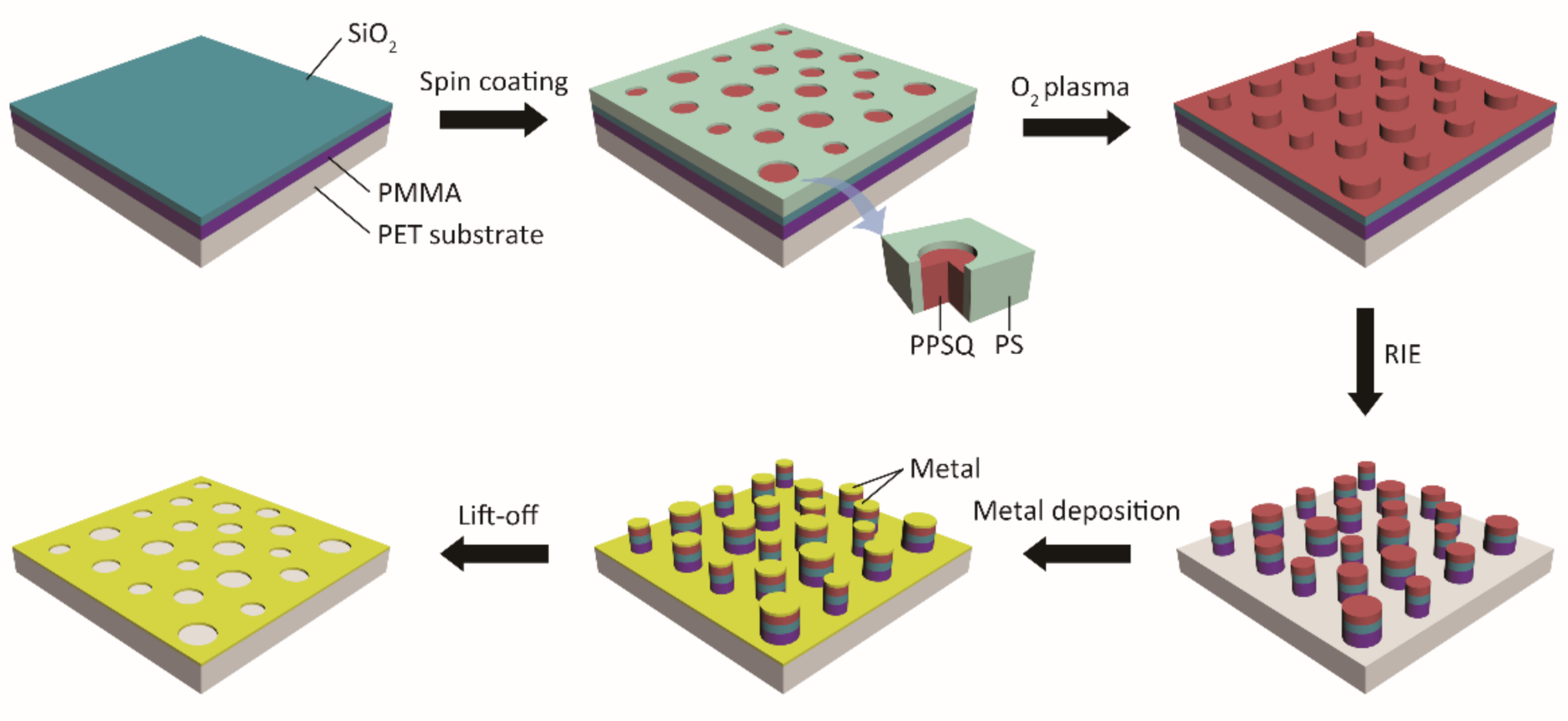
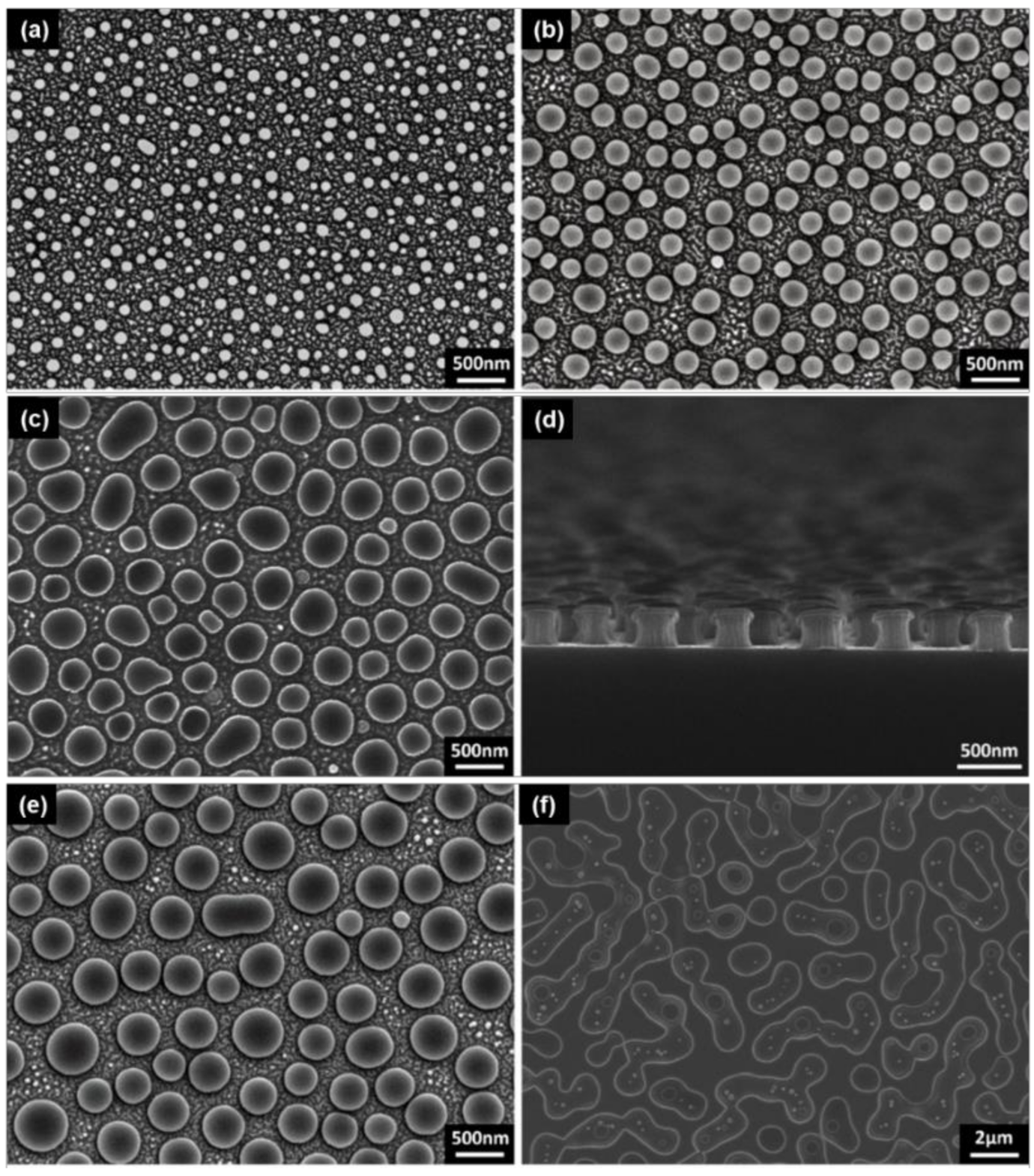
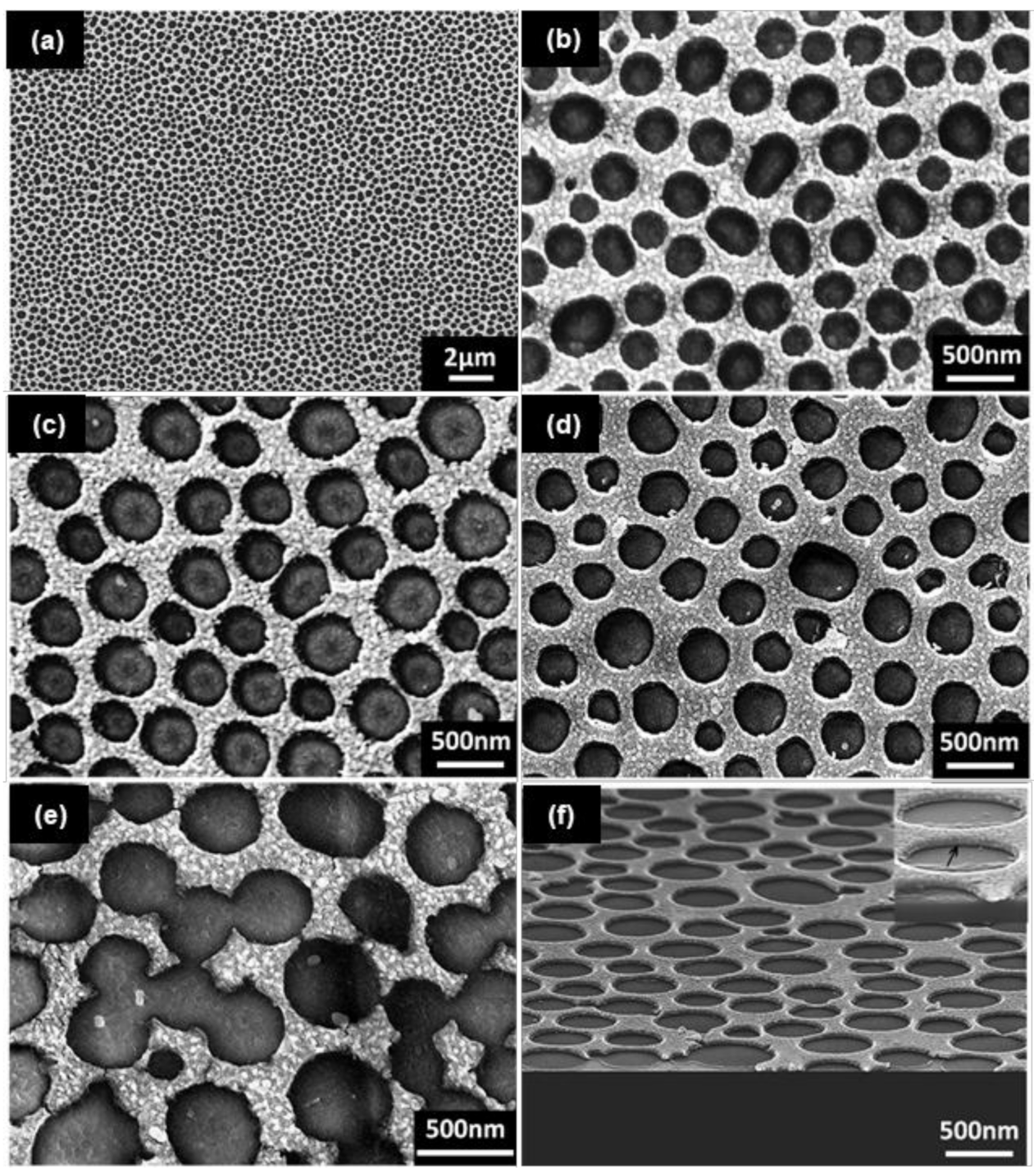

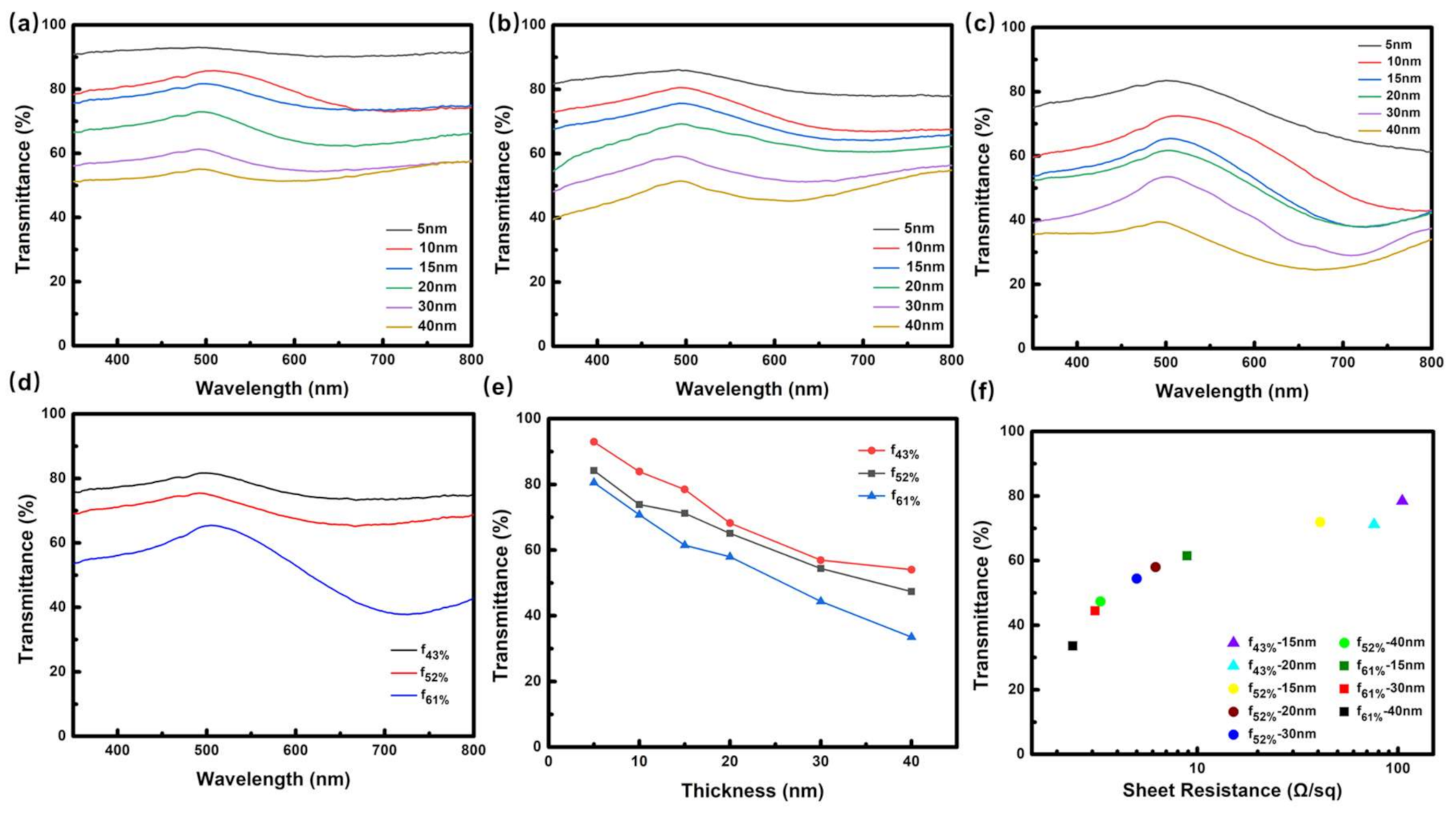
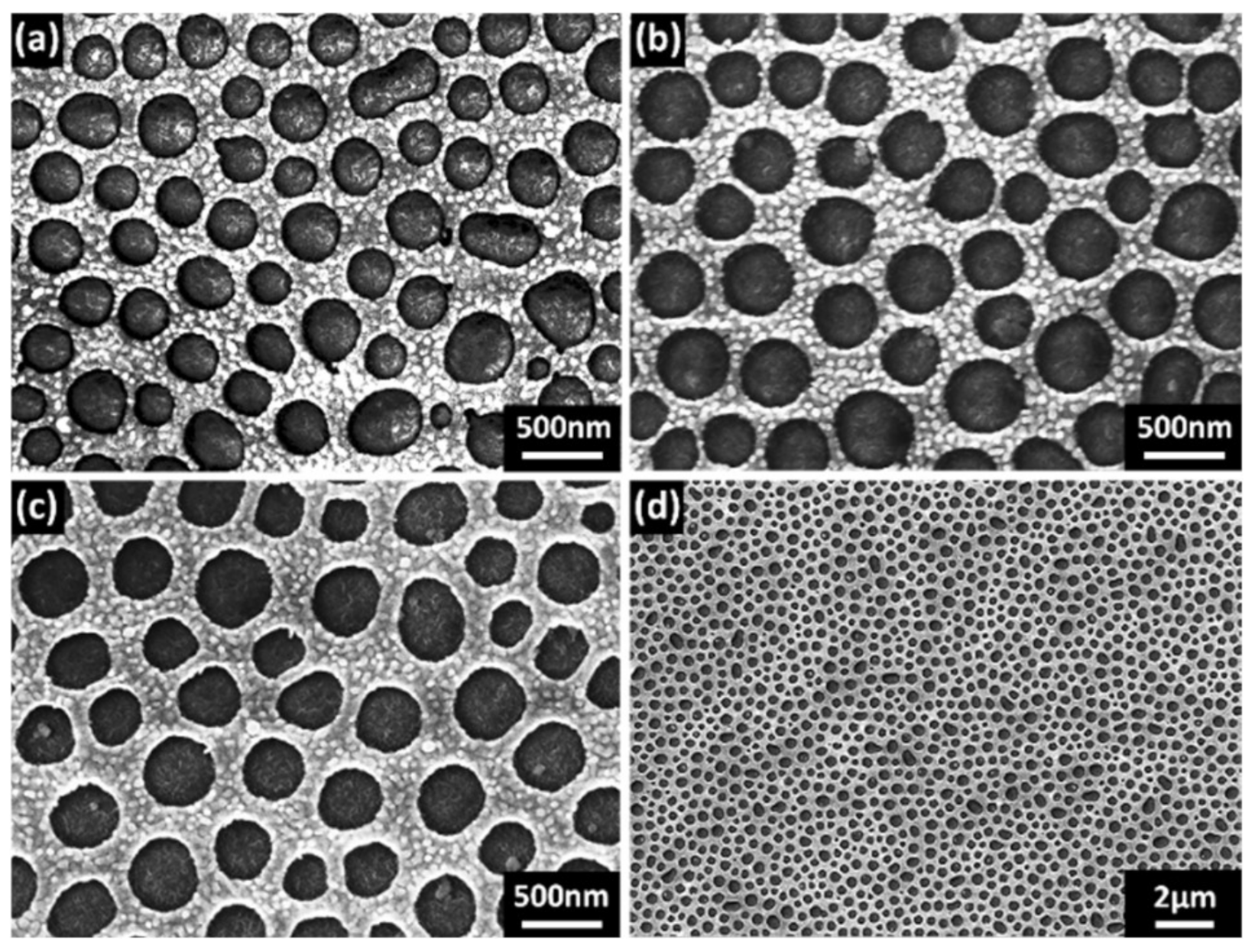


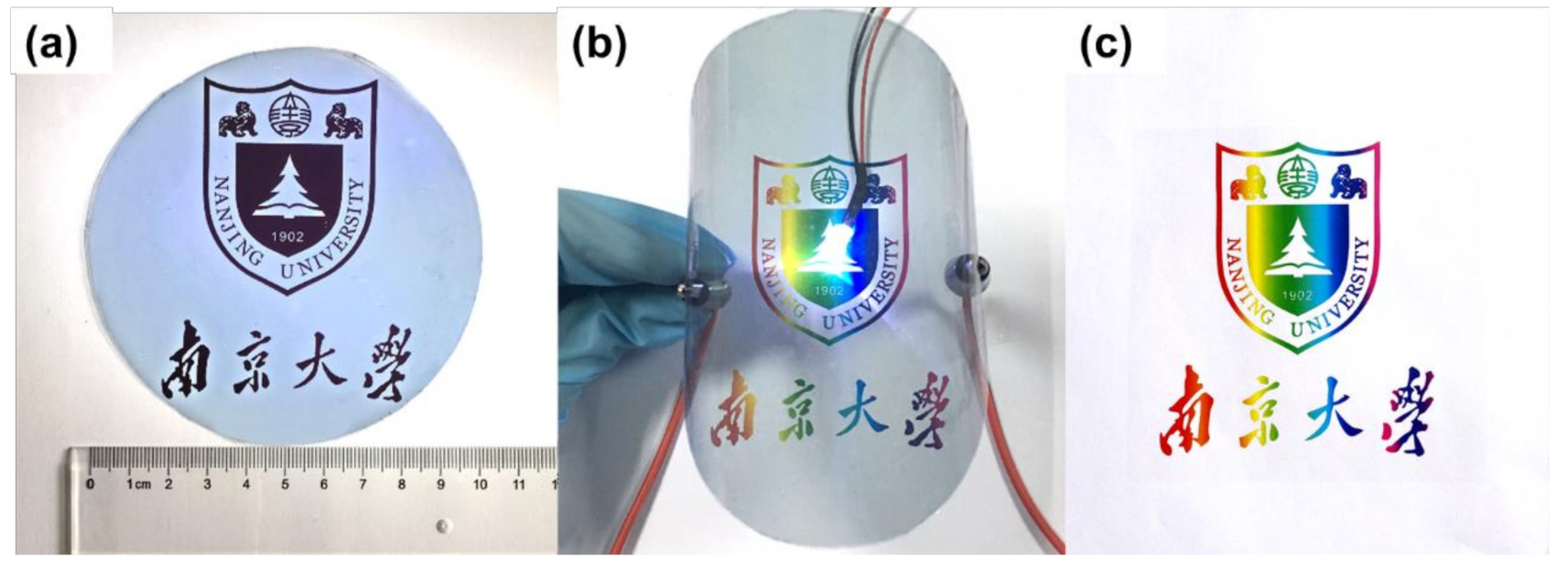

| PPSQ/PS Weight Ratio | Spin Speed (rpm) | Average Feature Size (nm) | Standard Deviation of Feature Size (nm) | Average Intervals (nm) | Standard Deviation of Average Intervals (nm) | Area Fraction (%) |
|---|---|---|---|---|---|---|
| 1:4 | 3000 | 94 | 21 | 337 | 59 | 20 |
| 2:3 | 3000 | 226 | 41 | 133 | 65 | 39 |
| 1:1 | 3000 | 382 | 67 | 105 | 48 | 64 |
| 3:2 | 3000 | 412 | 61 | 138 | 67 | 58 |
| 4:1 | 3000 | -- | -- | -- | -- | -- |
| Concentration (%). | RIE Time (s) | Average Aperture Diameter (nm) | Standard Deviation of Feature Size (nm) | Average Metal Wire Width (nm) | Standard Deviation of Average Intervals (nm) | Area Fraction (%) |
|---|---|---|---|---|---|---|
| 4 | 120 | 300 | 46 | 90 | 55 | 52 |
| 5 | 150 | 376 | 58 | 112 | 54 | 43 |
| 5 | 250 | 333 | 65 | 160 | 57 | 61 |
Publisher’s Note: MDPI stays neutral with regard to jurisdictional claims in published maps and institutional affiliations. |
© 2021 by the authors. Licensee MDPI, Basel, Switzerland. This article is an open access article distributed under the terms and conditions of the Creative Commons Attribution (CC BY) license (http://creativecommons.org/licenses/by/4.0/).
Share and Cite
Chen, X.; He, Y.; Chen, X.; Huang, C.; Li, Y.; Cui, Y.; Yuan, C.; Ge, H. Non-Iridescent Metal Nanomesh with Disordered Nanoapertures Fabricated by Phase Separation Lithography of Polymer Blend as Transparent Conductive Film. Materials 2021, 14, 867. https://doi.org/10.3390/ma14040867
Chen X, He Y, Chen X, Huang C, Li Y, Cui Y, Yuan C, Ge H. Non-Iridescent Metal Nanomesh with Disordered Nanoapertures Fabricated by Phase Separation Lithography of Polymer Blend as Transparent Conductive Film. Materials. 2021; 14(4):867. https://doi.org/10.3390/ma14040867
Chicago/Turabian StyleChen, Xinyu, Yuting He, Xiaofeng Chen, Chunyu Huang, Yang Li, Yushuang Cui, Changsheng Yuan, and Haixiong Ge. 2021. "Non-Iridescent Metal Nanomesh with Disordered Nanoapertures Fabricated by Phase Separation Lithography of Polymer Blend as Transparent Conductive Film" Materials 14, no. 4: 867. https://doi.org/10.3390/ma14040867
APA StyleChen, X., He, Y., Chen, X., Huang, C., Li, Y., Cui, Y., Yuan, C., & Ge, H. (2021). Non-Iridescent Metal Nanomesh with Disordered Nanoapertures Fabricated by Phase Separation Lithography of Polymer Blend as Transparent Conductive Film. Materials, 14(4), 867. https://doi.org/10.3390/ma14040867






